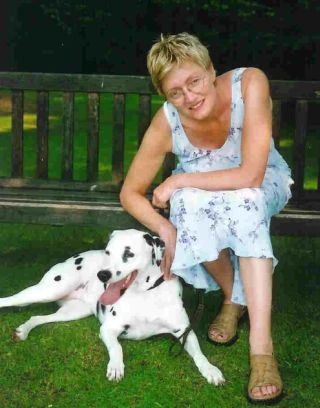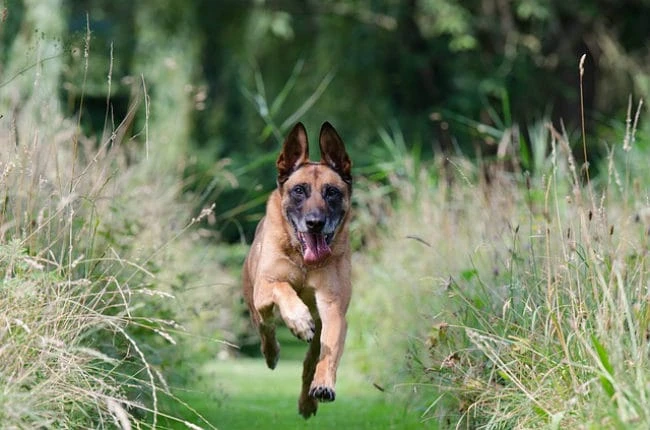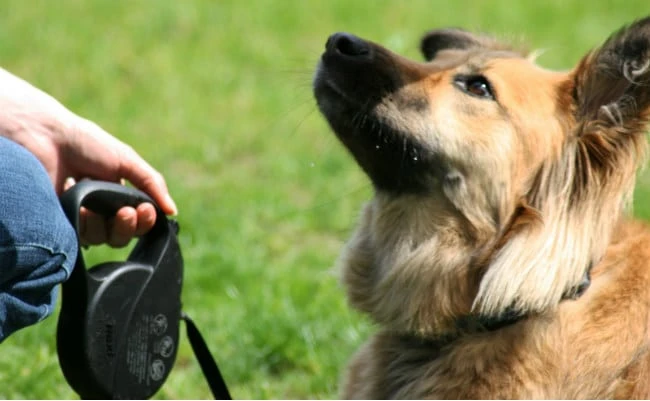An Interview with top dog trainer Denise Nuttall…


Denise Nuttall, APDT, DipCABT. Professional Dog Trainer
Today we are interviewing Denise Nuttall a very well known dog behavior and dog obedience training expert. Denise is a member of the CAPBT and DipCABT (Coape) acredited. We don’t want to waste any of Denise’s precious time so lets get started straight away…
1). Thanks Denise for taking the time to answer a few of our questions – could you explain a little about your background and how you started dog obedience training?
It all started about 11 years ago when we had a Dalmatian puppy from the age of 6 weeks. She was a little terror and we had our work cut out. At the time I was working in Investment Banking.
There weren’t any dog behaviorists around here then so I started to research how to solve our problems and one thing led to another. I did an advanced diploma with COAPE (Centre of Applied Pet Ethology) and am now just finishing a BSc in Applied Animal Behavior and am a student member of the APBC (Association of Pet Behaviorists).
I started a dog behavior practice and training school about 6 years ago and now I spend a lot of time helping people to solve problems with their dogs as well as preventing them through structured training courses. I work on a voluntary basis with a local dog rescue organization helping to improve prospects for dogs gaining a forever home.
2). Could you give our readers some tips on what you think are the best dog breeds to have around children – and is there any advice that families should consider when having a dog as a pet around small children?
I think the most important thing to realize is that irrespective of breed, the puppy’s temperament is the most important thing. If you are a busy active family and you choose a timid puppy (the one that hangs back and hides, the most endearing) this puppy will probably not cope in the environment and behavior problems are likely to occur. Children can be very challenging for a timid dog, so for a family with small children select a dog which is more confident but not too pushy.
There are many things to consider when choosing the right breed as each breed probably has a purpose. For example, border collies are herding dogs and don’t tend to cope in an urban environment especially if working lines as they need to chase everything… and there is a lot to chase too, making it difficult for the dog and the owner.
Cocker spaniels are bright dogs but people need to be aware of the difference between working cockers and show cockers. Working cockers are very high maintenance and need a lot of exercise and training which can be difficult to accommodate with a young family whereas the show lines are generally a bit easier. People need to research the breed and what their behavioral requirements are, if these don’t match with the family’s lifestyle, budget and time availability, then no matter how drawn you are to the breed, don’t get it.
Good first time dogs I think are Cockerpoos, they are quite biddable, quick to learn and have reduced risks of allergies to children. Selecting your breeder is the most important factor, choose carefully.
However, if you already have an older dog and then start a family it is really important that you prepare your dog for this. If you plan to start a family make sure you socialize your dog well with small children, especially toddlers, as a puppy because later on it is much more difficult for a dog to cope with children.
If you haven’t already done this and are worried, then contact a qualified dog behaviorist for advice on how to prepare your dog for your new arrival. Obviously never leave your dog unattended with a small child as you do not know what the child might do and you may not be aware of what your dog might do when afraid.
3). Could you give our readers some tips and advice on the best methods to stop their dog barking?
Barking has many causes and you need to get to the root of the cause before you can resolve the problem. Common causes are boredom, separation distress, noise sensitivity, watch dog, nervousness, and excitement. For boredom you would need to enrich the dog’s daily life by increasing exercise and mental stimulation with the use of toys such as Kongs and treat balls. You can hide food parcels and toys so your dog has something to do whilst you are out. A good long run before being left should help to satisfy the dog so he doesn’t need to bark.
Excitement is best managed by ensuring you only reinforce calm responses in the dog. For example, if your dog becomes extremely excited when he sees the lead, the lead doesn’t go on until he has decided to be quiet and calm, at which time you put on the lead. By reinforcing the calm behavior and ignoring the excitable the dog will choose to present calm behavior more often. By reducing the excitement levels in this way the dog doesn’t bark so much because he is less excitable.
Definitely best not to shout at the dog as this just creates anxiety which is likely to increase the barking. You should also teach your dog to stop barking on request. This can be done by attracting the dog’s attention with a toy or treat. When he stops barking to show interest, count to three and then give the cue “Quiet”. Then count to three again, if still not barking, reward with the treat or the toy. The second count of three needs to be increased over time. Timing is extremely important here because if you give the treat too soon you will be rewarding the barking so it will get worse and not better.
4). We are often sent emails regarding young puppies whining when they are in the crate – could you give our readers some tips and techniques on how to stop a puppy whining in his crate?
I think that DAP (Dog Appeasing Pheromone) is really great. DAP is a pheromone product which can help the puppy calm down. It is a synthetic version of a natural pheromone that the mother emits shortly after whelping to make the litter calm. It can really help puppies to settle down. If the puppy does cry try not to rush in too quickly as this will reinforce the whining. Over time they should settle down.
If they are struggling to settle, try bringing the crate into the bedroom and then gradually over the weeks move it outside of the room and along the hall. However, sometimes some puppies do become very distressed in which case I would suggest getting in a qualified behaviorist to help you to produce a plan of action.
Separation issues can be problematic and you can make things worse for a very sensitive puppy by not going to them and an expert should be able to help you to work out the best course of action. Separation issues are likely to be more noticeable if puppies have come away too soon from the mother or in certain breeds which seem to suffer more such as Boxers, Staffordshire bull terriers and Hungarian Vizslas.
5). What are the best techniques to stop a dog or puppy pulling on the lead?
Don’t pull on the lead as this creates a reflex response called negative thigmataxis. This basically means that if the dog feels tension he will pull away from it. Many people try jerking the lead which just makes the problem worse. Keep the lead loose and use a clicker to reinforce the correct position. Next thing, be aware of the rewards that your dog takes when he is pulling. What is your dog doing on the end of a tight lead? Usually sniffing, greeting, foraging or eliminating.
All of these behaviors are self reinforcing which means it is worth the dog pulling to do them. So, if you restrict your dog’s ability to do any of these things on the end of a tight lead then you will stop the pulling. All these behaviors can be done freely by the dog on a loose lead. You restrict by gently moving your dog away from the items they are trying to get too.
Make sure you use a wide collar so that you don’t hurt their neck/throat when you gently lift their head up to stop sniffing on the end of a tight lead. Also use a harness as well as a normal lead and collar as you must be very consistent with this technique. So when you are fed up with the training, attach the dog to the harness and have a break without ruining the training you have done by being inconsistent.
6). What are your views on Cesar Millan and his dog training techniques?
Cesar comes across as very charismatic and is a good communicator with people. I agree with his comments about being calm and assertive, but care needs to be taken with the word “assertive”. Assertive to me means be consistent and clear with your instructions to the dog but also be kind. If your heart rate increases your dog is aware of this and reflects your behavior which is why it is important to be calm.
I am disappointed that Cesar uses such out of date techniques. Pack leadership was debunked about 20 years ago by the guy who invented it, David Mech. He based his findings on studies of one captive wolf pack. Since this time the pack leader bit has stuck despite Mech publishing further studies criticizing his original study.
Science has repeatedly de bunked the dominance theory yet Cesar and some others continues to use it. I would like to see Cesar move with the times and be kinder to dogs. When in a state of stress it is biologically impossible for a dog to learn. I know that too well from when I was a child entering the maths classroom in fear as my teacher knew I was rubbish and picked on me every class. Funny that later on I became an Investment Banker using complicated maths. I could do maths but couldn’t learn under stress.
I wouldn’t let Cesar work with my dog because he doesn’t seem to read a dog’s body language. Most of the dogs that he seems to describe as dominant, I see as fearful. I don’t like the equipment he uses either as again they cause pain and fear. I remember watching the episode where he dragged a St Bernard up a spiral stair case because the dog was afraid to go up. He had a collar like cheese wire attached to the dog’s neck.
It took him hours of pushing, pulling and forcing the dog upstairs. It takes me about 20 minutes to achieve what took him many hours. By causing fear the dog will work against you to avoid the feared stimulus. If you change their emotion from fear to expectation, they voluntarily work with you. I would be very happy to watch Cesar on TV using the methods that Victoria Stillwell uses in It’s Me or the Dog USA. He’s nicer to people and she’s nicer to dogs so the two parts combined would be great TV!
7). Denise could you give our readers some advice on the best way to choose a puppy and what they should consdider when taking their puppy home?
When you choose a puppy you need to choose a good breeder first. In the United Kingdom there are many puppy farms. Find a breeder who knows what they are doing, and understands the critical development periods. The mother should be friendly and relaxed. Don’t take a puppy before 7.5 weeks of age.
I would find a home bred puppy and want to see the puppies with the mother inside the house. Be aware many puppy farmers know you expect this so will bring the puppies and mother inside for a short period. They will look unsettled if this is the case. By raising a litter indoors they are accustomed to things such as vacuum cleaners and washing machines, etc. Choose the puppy according to your lifestyle.
If you are a hectic family don’t get the sensitive one that hangs back, get the one that is more confident. Equally if you are a stay at home quiet family don’t get the really confident one as it will not be satisfied, the quiet one may be more suited to you. I would avoid the pushy ones too, the ones that jump up at you and grab your trouser legs etc. unless you are prepared to work at the relationship and put in a lot of training. See how happy the pup is to be picked up, does it struggle? If so, you might want to think about what you want. If you want to be able to cuddle the puppy this may not be the one for you.
If you want an independent one then this one may be good for you. You need to decide first why you are getting a puppy and what you want out of the relationship. Plan ahead. Also consider when you are going on holidays etc, don’t get the pup and then go away leaving it with someone else or in a kennel three weeks later! This would be very distressing as they need to settle in.
Once you get your puppy home let him settle down for a few days but do get him vaccinated as soon as possible so that you can start to take him out at the earliest opportunity. When the puppy has settled down start to ask visitors to come around so that your puppy gets used to people coming into his territory, also get friends to bring vaccinated dogs around too. Get him booked onto a reputable puppy training course so that he can start socialization and training really early.
Do be aware of the critical or sensitive periods. It is extremely important to let your puppy socialize with other people and dogs in lots of different places during the first 16 weeks. If you don’t make a start during this time your puppy will lack social skills forever. Be aware that you need to maintain socialization for at least a year as somewhere around 6-8 months dogs go through a second sensitive period. If you don’t maintain socialization what you did in the first 16 weeks can wear off.
8) As a member of the Association of Pet Dog Trainers who place a great emphasis on reward based training techniques and positive reinforcement – could you explain what this entails and how successful it is?
Positive reinforcement basically means that behavior is encouraged as it is rewarded by something pleasant. Dogs work very hard for rewards. Bad behavior is also done because it is rewarded in some way. So, when using rewards you need to be clear what your dog sees as a reward and have something better on offer.
We do need to punish bad behavior sometimes, but this is done without causing pain or fear to the dog. A natural dog will experience disappointment and some stress in life as he fails to catch a rabbit for example. This is called negative punishment. The dog experiences punishment because he has not received an expected reward. This is very effective in training as long as you use it wisely in combination with the dog knowing that he gets rewarded for the correct behavior.
You should only use this after your dog has received positive reinforcement and the main focus in training is positive rewards for good behavior. This is so much more effective than traditional punishment because the dog is not fearful and learns calmly to do the right thing without fear or stress. I believe it is the most effective way to train and many scientific studies have also concluded that the most effective way to train dogs is using positive reinforcement methods and to be consistent. Lack of consistency leads to confusion and intermittent rewards which can make behavior worse.
9). We often get emails regarding dog owners wanting to become dog trainers or at least do some basic courses – could you give some of our readers living in the UK some advice on the best courses to go for?
It looks like at last this industry will become regulated to some degree. This is really important because at the moment anyone can call themselves a dog trainer or behaviorist. It is only through the courses I have done that I have discovered how complicated this whole subject is. Initially I didn’t think education was necessary, I thought if I read a few books that would be enough.
It is being suggested that animal behaviorism in the United Kingdom will need to be regulated and it has been suggested that the minimum standard of education will be a degree in a relevant science (animal behavior, psychology). However, academic qualifications are not enough and you must have experience with the theoretical knowledge. I volunteered (and still do) at a dog rescue charity where I gained hands on experience and also you can volunteer at dog training schools.
This way you get practical experience. I completed the COAPE advanced diploma which is accredited by the open College Network and gained a lot of insight into animal behavior. But having just completed a BSc course I realize how little we know about dogs really and I plan to further my knowledge by doing a Masters degree. Even 6 years on training 120 dogs a week every week I still see some dogs that I can’t read and any expert who is honest will say the same!
My advice to prospective dog trainers and behaviorists is to gain practical experience through volunteer work and do a well run accredited course. If you are serious about doing this I would do a relevant BSc degree course so you are ready if regulation does some in.
10). Finally Denise what do you find the most difficult dog behavioral problems to cure and how did you cure them?
The most difficult cases are when dogs are genetically anxious as the dog has never not been anxious therefore, they have no safety history or concept of how to behave without fear. Fearfulness can cause many problems such as aggression, separation distress, barking etc. These cases may benefit from a combination of drug therapy prescribed by vets and behavior counseling.
Sometimes, dogs as with humans do not have enough serotonin receptors in the brain which means they do not function normally and are stressed and fearful all the time. You cannot rehabilitate these dogs unless you can change the mood state. A combination of drug therapy and systematic de-sensitization (careful and distant exposure to what frightens them) is the approach to take along with possibly counter conditioning (training a behavior in place of the fearful behavior) and it can take many months. The drugs should be selected carefully as some of them have amnesiac properties (i.e. dogs can’t remember). During rehabilitation the dog will need to be able to remember what they are learning.
Dogs which are genetically anxious can never really be rehabilitated but the effects of the behavior can be managed. These problems could be avoided if breeders were more careful about selecting the dogs they breed from and selecting them for behavior rather than appearance.
Go from here back to our list of dog training interviews or back to dog obedience training home-page




